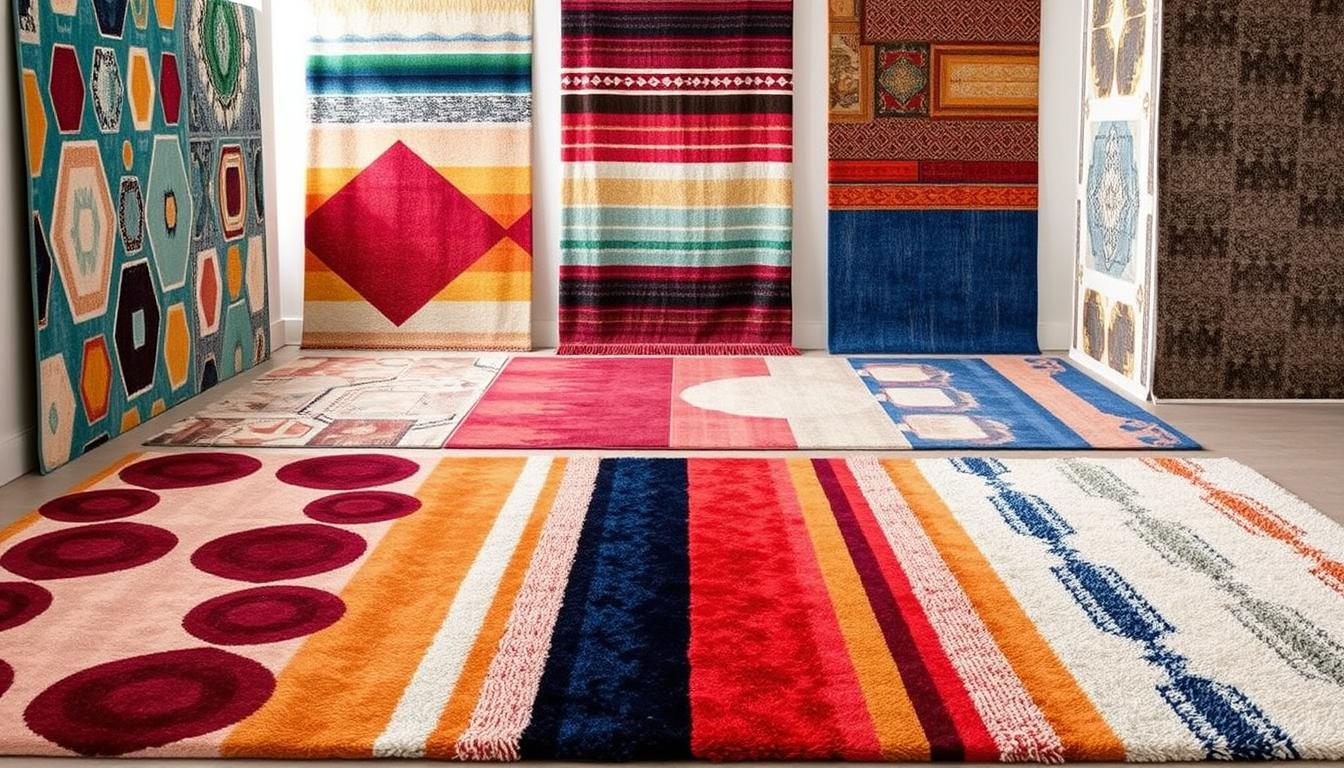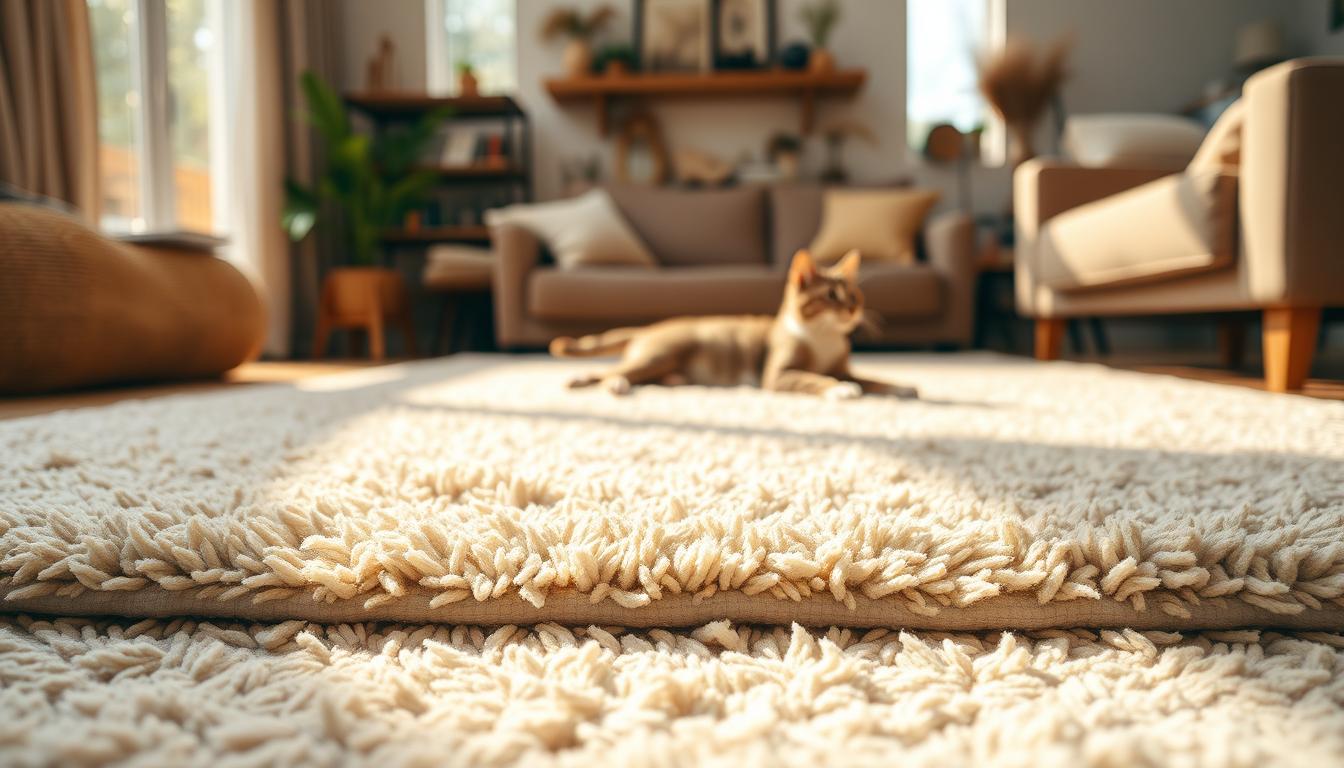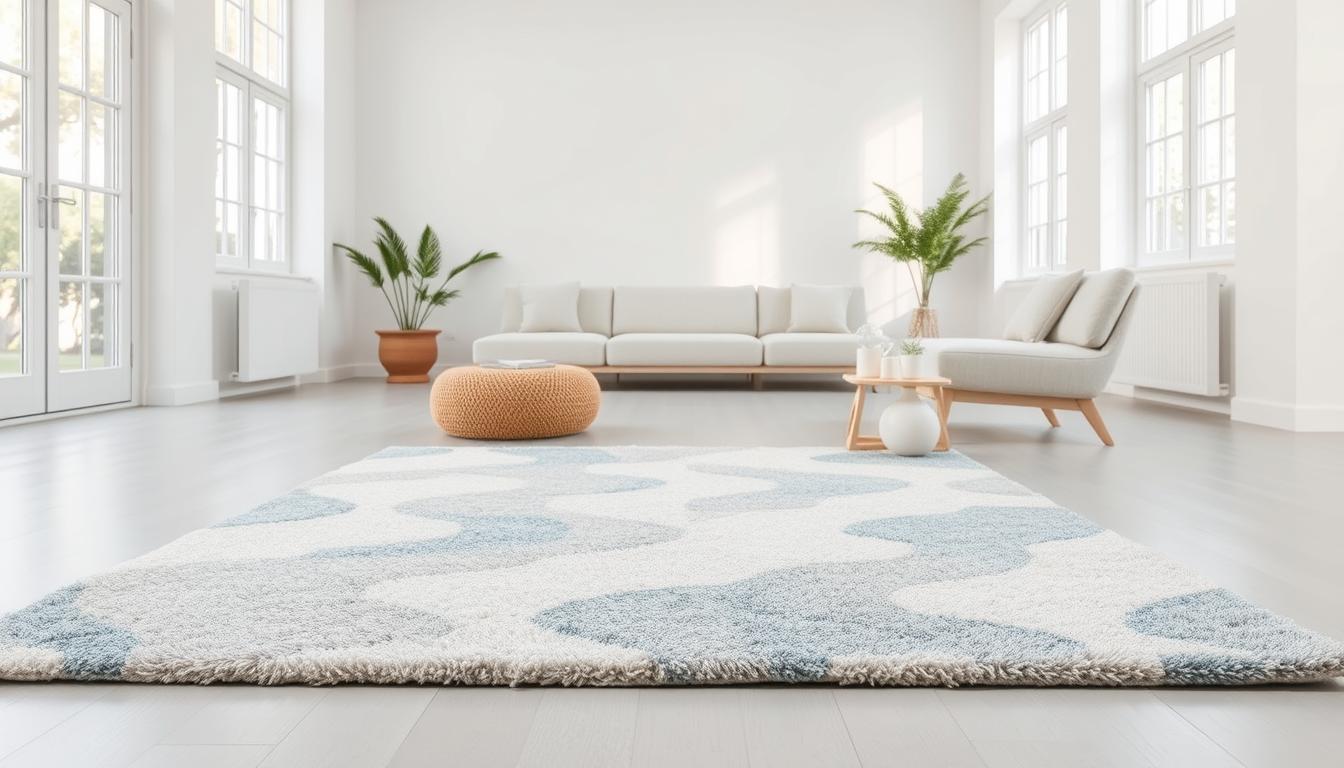
5 Clear Reasons Polyester Rugs Work
What if your next rug could blend luxury, practicality, and budget-friendly appeal—without sacrificing style? For years, natural fibers dominated interior design conversations, but synthetic alternatives like polyester are reshaping expectations. Modern homeowners increasingly prioritize solutions that balance aesthetics with everyday durability. Let’s explore why these options are turning heads.

Polyester’s rise stems from its ability to mimic high-end textures while resisting stains, fading, and wear. Unlike pricier materials, it offers a soft, plush feel ideal for living spaces or bedrooms. Busy households appreciate how spills wipe away easily, making maintenance stress-free. Plus, vibrant colors stay bold even in sunlit rooms—no weekly rotations needed.
Design flexibility is another perk. Whether you prefer minimalist neutrals or bold patterns, these floor coverings adapt to diverse decors. Their affordability lets you experiment without overspending. Curious how they stack up against other synthetic materials? We’ll break down the details.
Key Takeaways
- Cost-effective alternative to natural fibers, starting as low as $3 per square foot
- Stain-resistant surfaces simplify cleaning for active families
- Retains vibrant hues despite sunlight exposure
- Mimics the plushness of wool or silk at a fraction of the price
- Works in high-traffic areas due to synthetic durability
Understanding the Appeal of Polyester Rugs
Imagine stepping onto a floor covering that combines eye-catching visuals with sumptuous comfort—no compromises necessary. Modern manufacturing techniques give these pieces an edge, blending artistry with practicality for spaces that demand both style and resilience.
Stylish Designs and Vibrant Colors
Dye absorption in synthetic fibers has evolved dramatically. Advanced methods lock in pigments, ensuring intricate geometric motifs or floral patterns stay crisp for years. Unlike some materials that dull over time, these options hold bold hues even near sun-drenched windows.
From jewel-toned accents to subtle earth tones, color versatility lets you match any theme. A navy-and-gold medallion design anchors a formal dining room, while abstract splashes of coral energize a modern studio. The fade-resistant quality means your investment keeps its fresh-from-the-store appeal.
Luxurious Softness and Comfort
Run your fingers across the surface, and you’ll notice a velvety density rivaling high-end wool. Tightly woven fibers create cushioning that supports bare feet during morning coffee routines or playtime with kids. Bedrooms gain warmth, while living areas feel inviting without sacrificing durability.
This plush texture also dampens noise—a bonus in open-concept homes. Whether layered over hardwood or carpet, the underfoot experience transforms cold floors into cozy retreats. It’s practicality disguised as indulgence.
Benefits of Polyester Rugs Compared to Wool Rugs
When balancing style and practicality, material choice becomes critical. Synthetic fibers like polyester challenge traditional favorites by delivering comparable elegance at accessible prices—especially when matched against wool.

Affordability and Low Maintenance
Wool floor coverings often cost 3-5 times more than polyester alternatives. For a 8x10 area, expect to pay $1,200+ for wool versus $200-$400 for synthetic options. This price gap makes upgrading décor or replacing worn pieces feasible for most households.
Cleaning demands differ sharply. Wool absorbs spills quickly, requiring immediate professional treatment to avoid permanent marks. Polyester’s moisture-wicking fibers let you blot accidents swiftly with mild soap—no panic or expensive services needed.
| Feature | Polyester | Wool |
|---|---|---|
| Cost per sq. ft. | $2-$5 | $8-$20 |
| Stain Resistance | High | Moderate |
| Cleaning Method | DIY spot cleaning | Professional care |
Families with pets or kids benefit most. Juice spills or muddy paw prints? A damp cloth preserves the vibrant patterns of polyester rugs without fading. Wool’s natural oils attract dirt, demanding frequent deep cleans.
Long-term savings add up. Lower upfront costs combine with minimal upkeep expenses, freeing your budget for other home projects. While wool lasts decades, its high-maintenance reality often clashes with modern lifestyles.
Are Polyester rugs good? A Closer Look at Their Advantages
Choosing floor coverings involves weighing performance against practicality. Synthetic materials like polyester strike a unique balance—offering resilience where natural fibers falter while introducing limitations worth understanding.
Examining the Pros and Cons
These floor pieces excel in high-traffic zones due to their crush-resistant fibers. Unlike plush wool that flattens over time, they bounce back after furniture indents or footfalls. Fade resistance keeps colors vivid for 5-7 years, even near sunlit windows.
One trade-off? Oil-based spills—like salad dressing or makeup—can seep deep if not treated quickly. "Blot immediately with dish soap and cold water," advises New York-based interior designer Lauren Hart. Regular vacuuming prevents dirt buildup, extending their lifespan in busy households.
Ideal Areas for Polyester Rug Use
Focus on spaces needing softness without constant upkeep. Bedrooms benefit from noise reduction and morning comfort underfoot. Family rooms gain stain protection against snack spills or pet accidents.
Commercial settings leverage their durability too. Hotels use patterned options in lobbies to mask dirt between cleanings. Restaurants favor low-pile styles that withstand chair movement without fraying.
Their color retention and texture make synthetic options a strategic choice for design-focused businesses.
While not indestructible, these textiles offer a cost-effective solution for moderate-use zones. Pair them with quality padding to enhance cushioning and prevent slippage on hardwood floors.
Material Insights: Polyester vs. Polypropylene Rugs
Selecting the right synthetic rug material becomes simpler when you decode their chemical blueprints. Both options deliver unique strengths, but their core differences in composition dictate where they shine brightest. Let’s peel back the layers to understand which textile aligns with your lifestyle.

Composition and Durability Factors
Polyester originates from polyethylene terephthalate (PET), the same plastic used in water bottles. This gives it a silky texture and color-rich finish that mimics natural fibers. Polypropylene, known as olefin, uses hydrocarbon chains for lightweight construction. Its solution-dyed fibers bake pigments directly into the material during production.
Durability splits their advantages. Polypropylene resists mold, mildew, and moisture absorption—perfect for damp basements or outdoor patios. Polyester’s tighter weave handles foot traffic better indoors while retaining plushness. Neither material biodegrades quickly, but polypropylene often outlasts polyester in wet conditions.
| Feature | Polyester | Polypropylene |
|---|---|---|
| Base Material | PET | Olefin |
| Texture | Softer | Rougher |
| Moisture Resistance | Moderate | High |
Performance in Diverse Environments
Sunlit living rooms favor polyester’s fade-resistant dyes, which keep jewel tones vibrant for years. “Polypropylene’s UV resistance makes it ideal for covered porches,” notes Florida-based designer Marco Ruiz. Both handle spills well, but oil-based stains penetrate polyester faster without prompt cleaning.
Consider thermal properties: polyester insulates better against cold floors, while polypropylene’s moisture-wicking fibers cool spaces naturally. High-humidity areas like bathrooms or beach houses benefit from polypropylene’s mold resistance. For cozy bedrooms, polyester’s cushion-like feel often wins.
Your choice hinges on environment and usage. Need indoor warmth with stain resilience? Polyester fits. Prioritizing outdoor longevity? Polypropylene delivers. Both materials prove budget-friendly, but their specialized traits cater to distinct needs.
Texture and Underfoot Comfort: Enhancing Your Living Space
Transform your home’s atmosphere with floor coverings that pamper your feet while elevating décor. The tactile experience of a rug often determines whether a room feels inviting or utilitarian. Synthetic options now rival natural fibers in delivering sensory satisfaction—without demanding constant upkeep.
How Synthetic and Natural Fibers Compare
Walk barefoot across a high-quality synthetic piece, and you’ll notice a velvety density similar to wool. Tightly woven strands create cushioning that supports arches during morning routines or movie nights. Unlike jute or sisal, which can feel rough, these textiles offer cloud-like plushness perfect for lounging areas.
Natural fibers like cotton provide breathability but flatten faster under furniture. Polyester’s resilient bounce-back preserves thickness even in high-traffic zones. “The coziness factor makes synthetic options ideal for creating sanctuary-like bedrooms,” shares Boston designer Elena Torres.
| Feature | Polyester | Wool | Cotton |
|---|---|---|---|
| Texture | Plush, velvety | Soft, organic | Smooth, flat |
| Insulation | High | Moderate | Low |
| Maintenance | Easy spot cleaning | Professional care | Frequent washing |
| Cost per sq. ft. | $3-$8 | $12-$25 | $6-$15 |
Thermal properties further set these materials apart. Dense synthetic fibers trap heat 30% more effectively than wool, according to recent tests. Cold tile or hardwood floors gain instant warmth—ideal for drafty living rooms.
Balance practicality with indulgence by choosing pieces that soften footsteps and amplify comfort. Your space becomes a retreat where every step feels luxurious, yet maintenance stays simple.
Maintenance Made Easy: Cleaning and Stain Resistance
Keeping your floor coverings pristine doesn’t require hours of scrubbing—if you know the right techniques. Synthetic materials naturally repel water-based spills like juice or coffee, letting you tackle accidents quickly. Their tightly woven fibers prevent liquids from seeping deep, preserving vibrant patterns even after repeated cleanings.
Practical Tips for Everyday Care
Act fast when mishaps occur. For most spills:
- Blot—don’t rub—with a microfiber cloth to lift stains
- Mix 1 tsp dish soap with 2 cups cool water
- Rinse the area with a damp cloth, then pat dry
Oil-based substances like makeup or grease demand immediate attention. Sprinkle baking soda to absorb residue, then apply rubbing alcohol with a soft brush. "Quick action prevents synthetic fibers from trapping oily particles," advises cleaning expert Mia Tanaka.
Vacuum weekly using a suction-only setting to remove dirt without damaging strands. Rotate floor pieces every 6 months to ensure even wear. For deep cleans, opt for oxygen-based cleaners instead of harsh chemicals—they dissolve grime while protecting colors.
Busy homes benefit most from this low-efflict upkeep. Spend less time worrying about footprints or pet messes, and more enjoying plush comfort underfoot.
Budget-Friendly Options Without Compromising Style
Redesigning your space shouldn’t drain your wallet—or force style sacrifices. Modern synthetic floor coverings deliver luxury textures and bold patterns at prices far below natural fibers. Explore budget-friendly styles that elevate your decor while keeping funds free for other projects.
Cost Comparison and Long-Term Investment
A wool floor piece might cost $1,500 for an 8x10 size. Comparable polyester options? Under $400. This gap lets you refresh rooms more often or layer multiple pieces for depth. Lower upfront cost pairs with minimal upkeep—no pricey professional cleanings required.
Stain resistance adds value over time. Juice spills or pet accidents wipe away quickly, preserving colors for years. While natural fibers demand delicate care, synthetic materials handle daily life effortlessly. You save money and stress.
Durability ensures your choice stays vibrant even in busy hallways or sunlit living areas. Rotate styles seasonally without guilt—affordable options make experimentation easy. Why compromise when you can have both flair and function?
FAQ
How do polyester rugs compare to wool options?
Polyester offers a budget-friendly alternative with vibrant colors and easy cleaning. While wool has natural durability, synthetic materials resist stains better and cost less upfront. Both work well in living rooms, but wool may last longer in high-traffic zones.
Can these floor coverings handle spills or pet accidents?
Yes! Their stain-resistant fibers repel moisture, making them ideal for homes with kids or pets. Blot spills quickly to prevent deep absorption, and avoid harsh chemicals during cleaning to maintain their texture.
Where should I avoid placing polyester rugs?
Skip high-moisture areas like bathrooms or mudrooms. While durable, prolonged exposure to dampness can weaken fibers over time. Opt for polypropylene in wetter spaces for better moisture control.
Do they lose softness after washing?
Proper care keeps them plush. Use gentle detergents and cold water in machines. Air-dry instead of high heat to prevent shrinkage or stiffness. Regular vacuuming also preserves their cozy feel underfoot.
Are polyester designs as stylish as natural fiber rugs?
Absolutely. Brands like Safavieh and nuLOOM offer modern patterns, from geometrics to abstract prints. The dye retention is superior, ensuring colors stay bold even in sunlit rooms. You’ll find options mimicking jute or sisal without the scratchiness.
Which lasts longer: polyester or polypropylene?
Polypropylene wins for outdoor use or heavy wear due to UV resistance. Indoors, polyester’s softer texture holds up well in moderate-traffic zones like bedrooms. Rotate either type yearly to evenly distribute footfall impact.
What’s the best way to clean these rugs?
Vacuum weekly to remove dirt. For stains, mix mild soap with water and blot—don’t scrub. Professional cleaning every 12–18 months revitalizes deep fibers. Always check manufacturer guidelines to avoid damage.
Can I layer polyester rugs over carpet?
Yes! Their lightweight construction makes layering easy. Choose low-pile styles to prevent tripping. This adds visual depth to your space without permanent changes—perfect for renters or seasonal decor updates.
Do they emit strong chemical odors?
New rugs might have a slight smell from manufacturing. Air them outdoors for 24–48 hours before use. Brands like Lorena Canals use eco-friendly dyes, reducing odors while keeping hues vibrant.
Are they eco-friendly compared to natural fibers?
Recycled polyester options exist, like those from Fab Habitat. While not biodegradable, they reduce plastic waste. For sustainability, balance durability with your household’s needs—longer lifespan means fewer replacements.









